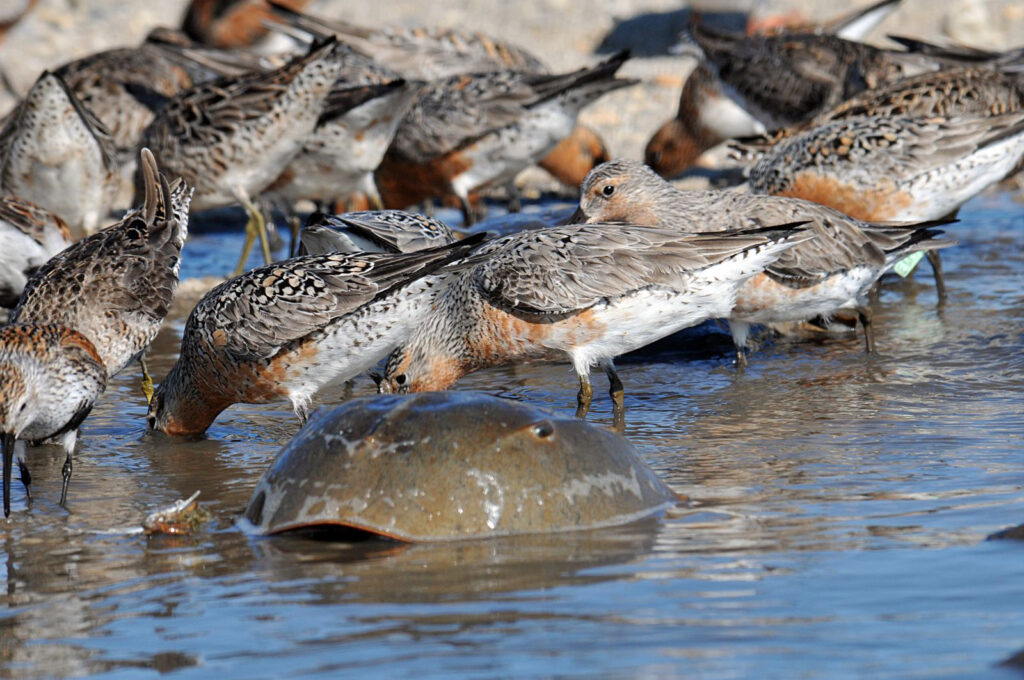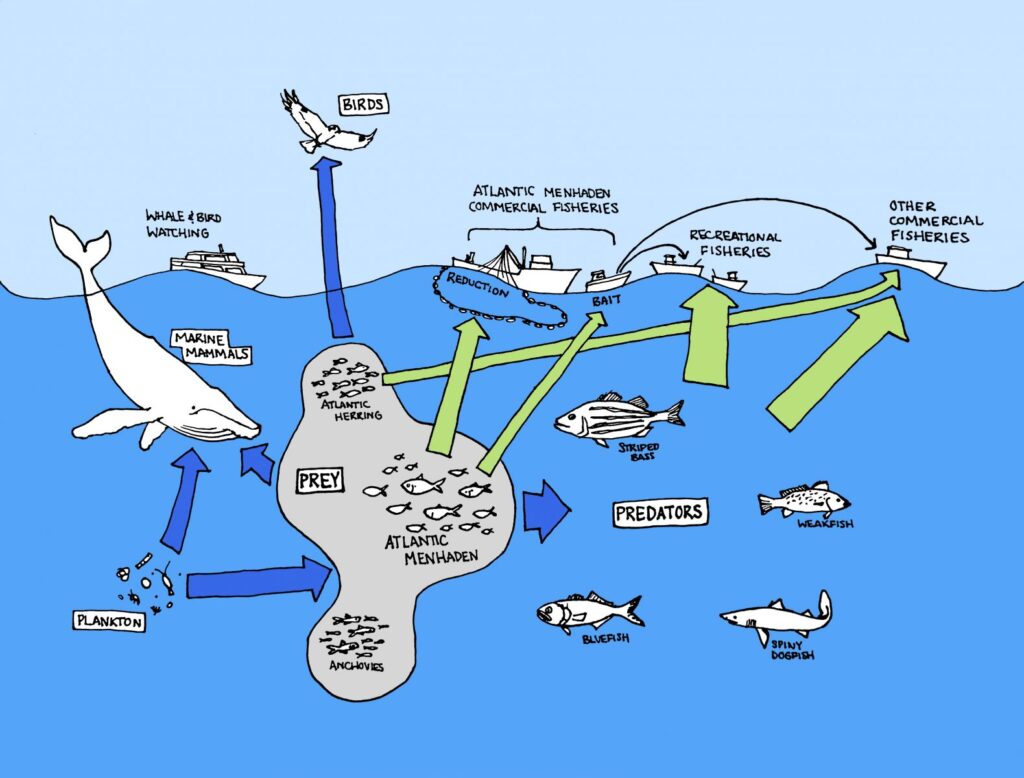Multispecies & Ecosystem Approaches
Explore how we integrate comprehensive management strategies across Atlantic coastal fisheries, focusing on the interconnectedness of species and their habitats. Discover our efforts to sustain diverse marine life and the communities that rely on them through coordinated, science-driven management.
Horseshoe Crabs and Shorebirds
Contact
Caitlin Starks, Senior Fishery Management Plan Coordinator (cstarks@asmfc.org)
The Commission uses an Adaptive Resource Management (ARM) Framework to set horseshoe crab harvest levels for the Delaware Bay Region. The ARM Framework uses horseshoe crab and red knot data and population models to set harvest levels for the fishery while also ensuring the horseshoe crab population in the Bay is not limiting the red knot population or slowing recovery.

Learn More
Horseshoe crabs are found along the Atlantic coast from northern Maine to the Yucatan Peninsula and the Gulf of Mexico. The Delaware Bay supports the largest spawning population in the world. During the high tide, horseshoe crabs come ashore to lay their eggs in sandy beach areas. Migratory shorebirds, like red knots which are listed as “threatened” under the US Endangered Species Act, stop and rest in the Delaware Bay region during this spawning period, and horseshoe crab eggs are an important food source for them on their long migrations. Horseshoe crabs are also harvested for use as bait in commercial fisheries for eel and conch, and their blood is collected to make Limulus Amoebocyte Lysate (LAL), a chemical that aids in the detection of human pathogens in patients, drugs, and intravenous devices.
Related Documents and Resources
-
Horseshoe Crab Stock Assessment Update Overview — 2024
-
Horseshoe Crab Stock Assessment Update — 2024
-
2022 Stock Assessment Overview — Horseshoe Crab
-
ARM Framework Assessment Overview
-
2021 Revision to the Adaptive Resource Management Framework and Peer Review Report
-
Horseshoe Crab Benchmark Stock Assessment and Peer Review Report — 2019
-
Horsehoe Crab Stock Assessment Overview — 2019
-
Horseshoe Crab Research Priorities
-
Horseshoe Crab Stock Assessment Update — 2013
-
Stock Assessment Overview for Horseshoe Crab — 2010
-
A Framework for Adaptive Management of Horseshoe Crab Harvest in the Delaware Bay Constrained by Red Knot Conservation — 2009
-
Horseshoe Crab Stock Assessment for Peer Review — 2009
-
Terms of Reference & Advisory Report to the Horseshoe Crab Stock Assessment Peer Review — 2009
-
Terms of Reference Report for the Stock Assessment of Atlantic Coast Horsehoe Crabs: A Proposed Framework — 2006
Atlantic Menhaden
Contact
Jainita Patel, Fisheries Science Coordinator (jpatel@asmfc.org)
Katie Drew, Stock Assessment Team Lead (kdrew@asmfc.org)
Atlantic menhaden (Brevoortia tyrannus) are small, oily, schooling fish of historical, economic, and ecological importance. Historically, menhaden supported large-scale commercial reduction fisheries, bringing considerable growth to Atlantic coastal communities. Today, the reduction fishery is a fraction of what it once was, with one processing plant and several vessels operating on the Atlantic coast. Additionally, menhaden are becoming increasingly valuable for use as bait in important fisheries, including American lobster, blue crab, and striped bass. Ecologically, the species plays an important role in marine ecosystems in converting primary production from small invertebrates (like plankton) into fish protein and as a forage fish (prey) for many fish, seabirds, and marine mammals.
Overview
Given Atlantic menhaden’s critical role in the marine ecosystem and commercial fisheries, the Commission invested considerable resources in developing an ecosystem model that ensures enough menhaden are left in the water coastwide to sustain not only the fisheries that target menhaden but also the key predators that rely on them.
Ecological Reference Points
Efforts to take into account menhaden’s role as a forage fish began in the early 2000s with the development of the multispecies Expanded Virtual Population Analysis (MSVPA-X) model. The Commission’s Ecological Reference Points (ERP) Work Group explored a suite of models to develop ERPs, ranging from very simple to very complex. The ERP Work Group ultimately recommended using the Northwest Atlantic Coastal Shelf Model of Intermediate Complexity for Ecosystems (NWACS-MICE) in combination with the single-species model to evaluate tradeoffs and set ERPs for Atlantic menhaden.

NWACS-MICE is a streamlined ecosystem model for Atlantic menhaden that includes Atlantic herring, bay anchovy, striped bass, weakfish, spiny dogfish, and bluefish. Using this model in combination with the single-species model, the Atlantic Menhaden Technical Committee, Stock Assessment Subcommittee, and ERP Work Group developed ecosystem-based reference points for menhaden that account for its role as a forage fish. ERPs were adopted for use in the management of Atlantic menhaden in August 2020 and since then have been used by the Atlantic Menhaden Board to set total allowable catch.
The ERP Work Group works to update the NWACS-MICE and other potential models every few years to ensure that the most recent data are being used to manage this important species. The next ERP update should be completed in 2025. At the link below, scroll through photos and figures to better understand what ERPs are, how they are used in the management of menhaden, and how they work towards achieving ecosystem approaches to fisheries management.
Related Documents and Resources
ERP
MSVPA Documents
Other Resources
Get Hooked on ASMFC News
Dive into the latest updates and catch all the important news by joining our newsletter mailing list. Stay in the loop with meeting agendas, fisheries management news, and more.